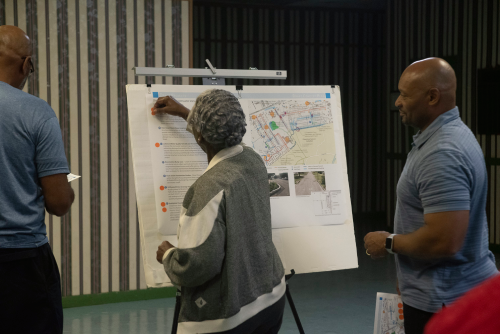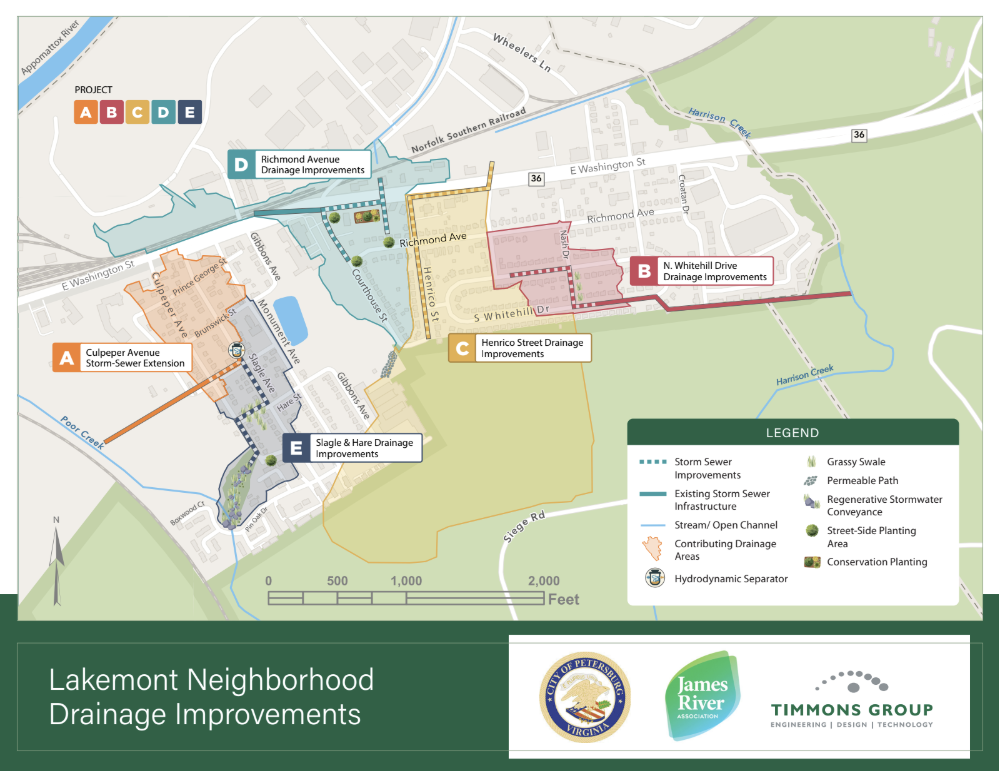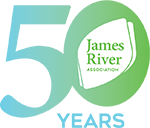Petersburg's Lakemont Community
Some residents of Petersburg’s Lakemont and Whitehill neighborhoods have experienced localized flooding as a result of an inadequate storm sewer system in recent years. Poor drainage in areas of the community is exacerbated by the increasing frequency of heavy rain events fueled by climate change. The Petersburg Walkable Watershed Concept Plan (2016) and Lakemont Neighborhood Drainage Study (2019) identify projects capable of alleviating flooding in the community. The City of Petersburg’s Stormwater Management Program is actively working to design and implement drainage improvement projects with support from the James River Association and Timmons Group. Information about projects and a map providing an overview of the Lakemont Neighborhood drainage improvements is provided below.
Culpeper Avenue Storm Sewer Extension – COMPLETE
The Culpeper Avenue Storm Sewer Extension project, which reduces flooding in the vicinity of Brunswick Street and Slagle Avenue, was successfully implemented in 2021. The project adds capacity to the storm sewer system and includes 225’ of new storm sewer pipe and Petersburg’s first hydrodynamic separator, a structure in the ground that improves local water quality by separating pollutants from stormwater.
N. Whitehill Drive Drainage Improvements – FIRST PHASE COMPLETE
The N. Whitehill Drive Drainage Improvements project seeks to reduce flooding caused by an undersized and dilapidated sewer system in the vicinity of N. Whitehill Drive and Nash Street. The project was designed by Timmons Group and features new storm sewer pipes and grassy swales to better manage stormwater. Two grassy swales were installed along Nash Street between N. Whitehill Drive and S. Whitehill Drive in 2024. The second phase of the project Includes new storm sewer pipes to be installed under N. Whitehill Drive and Nash Street.

Henrico Street Drainage Improvements – STUDY COMPLETE
The James River Association was awarded a planning and technical assistance grant from the National Fish and Wildlife Foundation’s Chesapeake Bay Small Watershed Grant Program to support this drainage improvement project. Timmons Group studied Henrico Street in order to identify engineered solutions to flooding experienced by residents in the vicinity of S. Whitehill Drive, Henrico Street, and Appleton Street. Final engineering design is complete.

Did you know stormwater runoff pollutes our waterways and contributes to localized flooding?
- When rain falls on impervious surfaces such as roads and sidewalks, it becomes stormwater runoff
- If stormwater runoff carries pollutants such as dirt, nutrients from lawn fertilizer, bacteria from pet waste, or toxics like oil from cars as it flows across an impervious surface to a river or stream, it becomes stormwater pollution
- Stormwater runoff contributes to localized flooding in the Lakemont and Whitehill neighborhoods as a result of inadequate storm sewer infrastructure
Green infrastructure is a solution to stormwater pollution and localized flooding.
- Green infrastructure includes trees, rain gardens, and grassy swales that enhance our built environment for the benefit of humans and the ecosystem of which we are a part
- Green infrastructure contributes to healthier communities by intercepting and filtering stormwater runoff before it enters our rivers and streams, improving air quality, and reducing the urban heat island effect
Go Green at Home!
Richmond Avenue Drainage Improvements – PLANNING UNDERWAY
Residents living in the vicinity of the intersection of Richmond Avenue and Courthouse Street have reported localized flooding as a result of a dilapidated storm sewer system. A Planning and Technical Assistance grant award from the National Fish and Wildlife Foundation’s Chesapeake Bay Small Watershed Program is supporting an assessment of the existing storm sewer system in the vicinity of Richmond Avenue and Courthouse Street for the purposes of identifying solutions to localized flooding, strengthening community resilience, and improving water quality in nearby Harrison Creek.
Slagle Avenue & Hare Street Drainage Improvements – PLANNING UNDERWAY
The intersection of Slagle Avenue and Hare Street experiences localized flooding on a regular basis. A Planning and Technical Assistance grant award from the National Fish and Wildlife Foundation’s Chesapeake Bay Small Watershed Program is supporting an assessment of the existing storm sewer system in the vicinity of Slagle Avenue and Hare Street for the purposes of identifying solutions to localized flooding, strengthening community resilience, and improving water quality in nearby Poor Creek.
Lakemont Neighborhood Drainage Improvements Projects Map

Questions?
If you have any questions about these projects or would like to report flooding in the neighborhood, please contact Justin Doyle, the James River Association’s Director of Community Conservation, by calling (804) 543-5479 or emailing jdoyle@thejamesriver.org.
Many Thanks to our Partners

This project has been funded wholly or in part by the United States Environmental Protection Agency under assistance agreement CB 96387301. The contents of this document do not necessarily reflect the views and policies of the Environmental Protection Agency, nor does the EPA endorse trade names or recommend the use of commercial products mentioned in this document.
